What I have learned so far
My first crowdfunding campaign
I have a series of crowdfunded projects planned for Kickstarter.
Kickstarter is a crowdfunding platform where people create campaigns for creative projects. Campaigns run for a set time. Projects are funded by a large number of people pledging small amounts of money to help create a tangible product.
Pledges are effectively promises to give money; backers only pay if the total pledges reaches the funding goal by the end of the campaign. If the funding goal isn't reached, no money is taken from the backers. A campaign can exceed its funding goal.
To get used to the logistics of planning and running a crowdfunding campaign, I decided to self-publish my short stories as my first campaign.
See my campaign on Kickstarter.
UPDATE: My campaign was successful!
I wrote some short stories several years ago - they happen to be erotica. My first crowdfunding campaign is to raise funds to self-publish my erotica as a book, fingers & tongues.
Why erotica?
When I was reading erotica in print or online, I found it unsatisfying. It either made me cringe - from cheesy dialogue or embarrassing characterisations of women - or frustrating - poor writing or a lot of dialogue. Over a period of two years, I wrote the kind of erotica that I wanted to read. I posted it to an online forum that had 250,000 subscribers. I got high ratings and great reviews.
You can read more about why I wrote erotica in my essay: My feminist porn.
I first thought of turning my short stories into a book in 2004, when I created a draft manuscript. The book needs proper editing by someone other than me, otherwise it's good to go.
Just to be clear, yes, I needed a small project for my first Kickstarter but I still think my stories are awesome. I've always wanted to see them as a printed book. I know how important it is to portray women in a powerful way in material that appeals to men as well as women.
Learning new skills
I decided to use my first crowdfunding campaign to raise the funds to get the book finally into print. I want to publish two kinds of books: just the stories in a handy paperback plus a bigger book that also includes the stories behind the stories.
In the process, I have learnt several skills that I can use in the future, even if this first campaign isn't successful:
- how to write a campaign pitch
- how to calculate core costs to arrive at a minimum funding goal
- how to record and edit speech
- how to make a video using stock footage, stock music and audio files
- what details a book printer needs to provide a print quote
- how to think about campaign rewards
- how to approach marketing
During the campaign, I'll gain experience of:
- keeping backers informed with regular updates
- acting on feedback and suggestions to improve my pledge levels
- ongoing promotion of the campaign by contacting relevant bloggers and magazines
If my campaign is successful, I will have to:
- manage the expectations of tens or hundreds of backers
- arrange for my stories to be edited
- hire and manage a book designer if I exceed my funding goal
- design and produce 1-3 books
- design and create an eBook
- learn how to create an eBook in various formats
- get 1-3 books printed, with special effects (embossed cover) if funds allow
- package and post the books to backers around the world
- deliver the eBook to backers
If my campaign doesn't reach its funding goal, I might still publish my short stories on Amazon as an eBook on Kindle. This will mean that I will learn these additional skills:
- how to create an eBook for Amazon
- how to get an eBook onto Amazon
Research
To learn about crowdfunded campaigns, I read a lot of articles.
I started off with Linda Liukas's post about how she prepared for her own campaign - her book Hello Ruby to teach children programming achieved 3,807% of the original goal of $10,000. She's one of these people who share knowledge. Her post with links to articles she found useful was fantastic.
My children’s book on technology raised 100k within 24 hours - here’s how
I read every article she recommended. I also bought the eBook IT WILL BE EXHILARATING by Studio Neat, which is now available to read online for free.
I listened to a few podcasts by Richard Bliss from his Funding the Dream series. I had found him via a Kickstarter LinkedIn group. His information is really good.
Finally, after spending two weeks on my campaign page and not being happy with it, I googled for Kickstarter templates.
I found Kickstarter Project Description Template. I saw "B PPP S BBBBBBBBBB S PP B S BBBBBBBB S B" and initially thought it was written by a mad man. But I read on and I understood what it meant. I changed my campaign page accordingly and suddenly it felt right.
Key takeaways
The main things I learnt were:
- launching a campaign is the last step in a crowdfunded project, not the first step
- aim to get 25% funding on the first day
- the algorithm Kickstarter uses to calculate a popular project divides activity by the number of days the campaign has been live - therefore a lot of activity on the first day will more likely trigger the Popularity setting
- try to get on the Popular page on the first day - the resulting momentum of backers should then keep you there
- no-one wants to be associated with a loser - people won't want to back a project with no backers
- people want to be associated with success
- when people back a project, they're effectively joining a tribe - look after your tribe
- use your existing contacts to ask for support - ask them to fund at the minimum level
- find out who blogged or promoted past successful projects in the same area, compile a list of magazines, sites, bloggers and writers - contact a short-list based on readership to say why their readers will be interested in your project - co-ordinate a blog post by bloggers the day of the campaign launch
- most backers don't watch the whole video - some backers don't watch the video at all
- $25 is the most popular pledge level
- include a high pledge level to make the highest realistic pledge seem reasonable
- convince people that you have the necessary experience and know-how to deliver the project
- make it easy for people to back the project with money only
- the first and last weeks of a campaign are the busiest - the middle is effectively dead time - keep promoting
- don't make a campaign more than 30 days (I am choosing 21 days - 3 weeks)
- prepare update messages in advance
- prepare the version of the campaign page that will exist after the campaign - update it in the last hour (campaign pages can't be changed once the campaign has ended) - turn it into a landing page
- American magazines are interested in the use of Kickstarter as raising funds more than the project itself (I might approach Boing Boing and Cracked)
- try to create "surround sound" - people hearing about the project from more than one place
- don't launch or end on the same date as other projects in the same category (by looking at places like Prefundia for yet-to-launch campaigns, and the end date of existing campaigns)
- add incentives based on number of backers during the campaign (e.g., if we reach 100 backers, I will add...)
- it can take a week for a campaign page and bank account to be approved on Kickstarter - therefore set it up as soon as possible in draft mode
Fulfilment
Creating and sending out rewards came up quite a lot in the articles I read. People often didn't allow for postage and packaging time and cost in their goal.
I contacted printers I'd used before and, after many iterations, got estimates to print (set-up, print and deliver) the three kinds of book at various quantities.
For each book (three sizes and weights) I have worked out the max costs for packaging and postage to the UK, Europe and rest of world. I have backed campaigns where the shipping cost is nearly as much as the pledge level. For example, the shipping cost to the UK for the Hello Ruby book was prohibitive. When planning the rewards for my campaign, I was mindful of this; I decided to simplify shipping outside the UK. I'll instead take a small hit on the profit margin for books shipped to the US.
Finally, I've looked into hiring a Franking machine for a month as a business user to save on delivery costs depending on the number of backers who want a printed book.
Rewards
One article I read suggested simulating different scenarios of pledge distribution. Since I love working with spreadsheets and visualising data, this was right up my street!
I created a spreadsheet showing actual set-up, print and delivery costs for the books. I calculated the unit price including delivery from the printers. I worked out what my reward levels would be after several iterations.
I then created another sheet to show how much money would be raised with different distributions of a number of backers at the various reward levels. The scenarios vary from most people wanting the cheapest reward (the eBook) to more people wanting physical books.
The bar chart below shows the minimum number of backers I need for 22 scenarios that just reach the funding goal of £1,900.
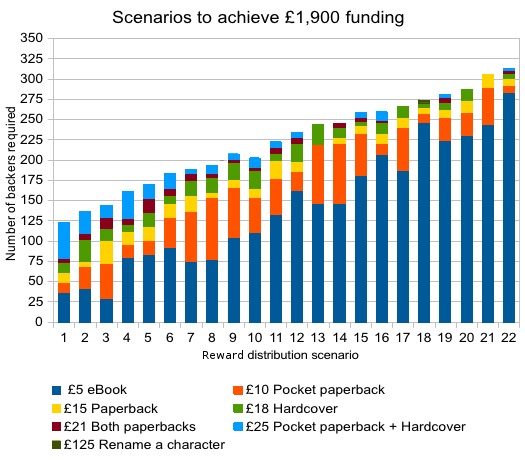
Creating the campaign page
I decided to use Prefundia to work on my campaign page before launch. I know from writing in the past that, unless I think that someone is reading something, it's hard to put myself in the right mode for writing.
I created a bitly link to my Prefundia page. Bitly is a short-link service. It also provides stats to links (geography and referrers).
Making the video
I spent a lot of time looking at Kickstarter projects of erotica books. Most didn't succeed. The campaign videos showed the author in an unflattering way. I realised that I didn't want to put my face on the campaign - I didn't want to influence what people imagined the characters in the stories looked like.
A campaign that succeeded was Coming & Crying: real stories about sex from the other side of the bed. The video featured people reading extracts from the book. I really liked it. I could see why it succeeded.
I asked around about getting help to make a video like that for free. I then started looking for royalty-free stock footage. As soon as I saw Beachfront's video of projector film, I knew what direction I could take.
I have a Mac now. I opened iMovie and started trying things out. By the end of the day, I'd created my first ever video!
- added stock video footage by Beachfront
- detached the audio so that I could change the sound level
- set-up Frank's studio-grade microphone to record myself
- used Audacity to clean up the sound file and later to cut 2 mins from the second reading
- created titles and transitions in iMovie
- realised that I'd learnt from decades of watching film/TV in overlapping sound with intro slides
- uploaded to YouTube
- I found out how to change the frame YouTube uses as the video thumbnail
The version on the campaign page is just my second version (different stock footage for the second story and a shortened story).
What's the story?
I spent two weeks on the page, never really happy with it and realising that I didn't actually know what story I was telling about my book. I thought it was a story about me as a Usenet poster 20 years ago. But actually, the reality is that I wrote the stories because I couldn't find erotica that didn't make me cringe or didn't frustrate me from the diversions into dialogue.
I found the term "feminist porn" and decided to try to get to the bottom of what I was trying to achieve when I first wrote the stories 20 years ago. The result is my blog post My feminist porn. I tweeted it and also asked a woman I follow on Twitter for a retweet. I got three new followers on my Prefundia page as a result.
Getting Kickstarter approval
I was originally going to use the Kickstarter crowdfunding platform for my erotica project. I read the submission guidelines which doesn't allow any pornographic material. I wasn't sure whether that included the project outcomes too.
I was worried that my project would be rejected by Kickstarter. I researched online for the definitions of pornography and erotica. My stories are erotica in that they are written and feature consensual sex. However, they're not erotica because they're very light on story, character and dialogue. They could be considered as Porn without Plot.
On the other hand, my short stories are porn because they're specifically designed to stimulate the reader. However, they're not porn in that they're not video, not made by men, not made for men, not created from the male perspective, and don't objectify women.
Kickstarter approved my campaign. I breathed a huge sigh of relief.
Campaign wording
I discovered fiverr.com - an online market place for products and services starting from $5. I bought an "honest book review" from Cheezees. It reassured me that my stories were as good as I thought they were. I was also able to use some of her comments in my campaign page.
I bought alternative headlines from ralphie2. I use some of them on my campaign page:
- Smart erotica with women and men as sexual collaborators
- At last, smart erotica that satisfies both men and women
- Smart erotica: sex, pleasure, and getting off
Campaign graphics
I haven't designed the book yet but I wanted something striking for my project thumbnail. I saw from other people's campaigns that they can look amateurish.
I went through my archive of digital art I created a few years ago. I picked a floral image that looks great on screen.

I used it as my campaign image and also at the start of my video.
Kickstarter offers very few formatting options for the campaign page other than headings, lists, bold and italics. People are resorting to graphics for formatted text. It's the 1990s all over again!
My first graphics describing the different rewards and pledge levels were okay but amateurish:
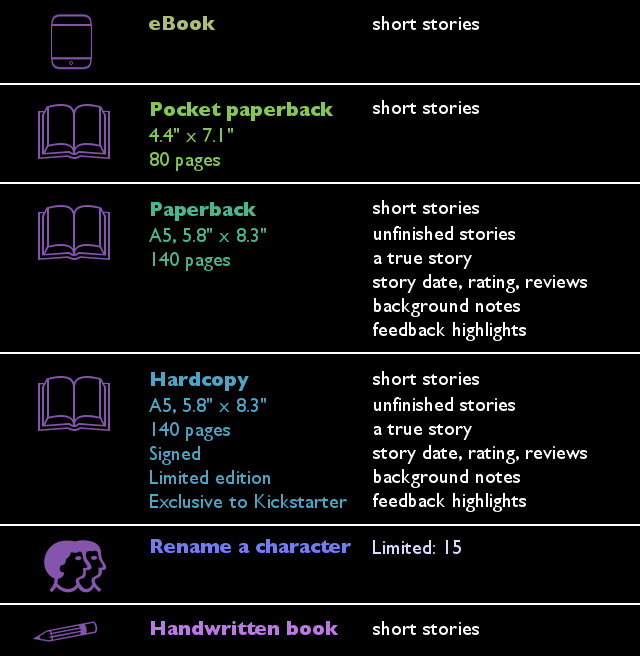
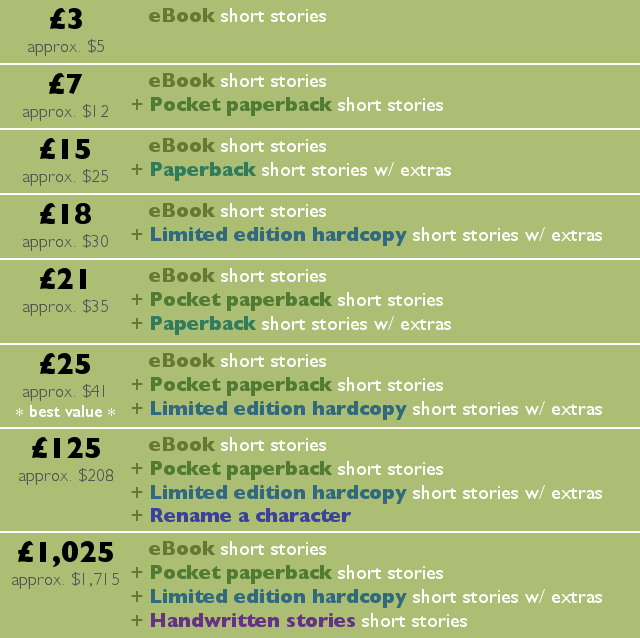
I searched for other campaign graphics for better examples:
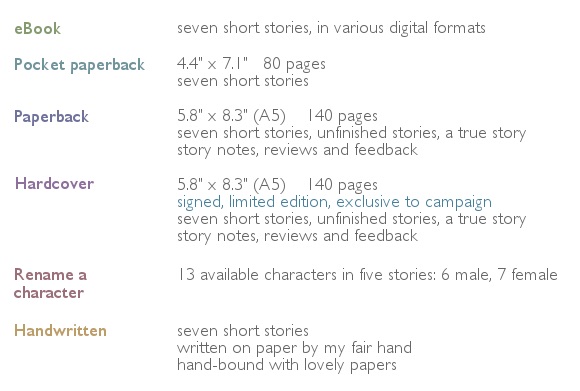
My second version was a big improvement:
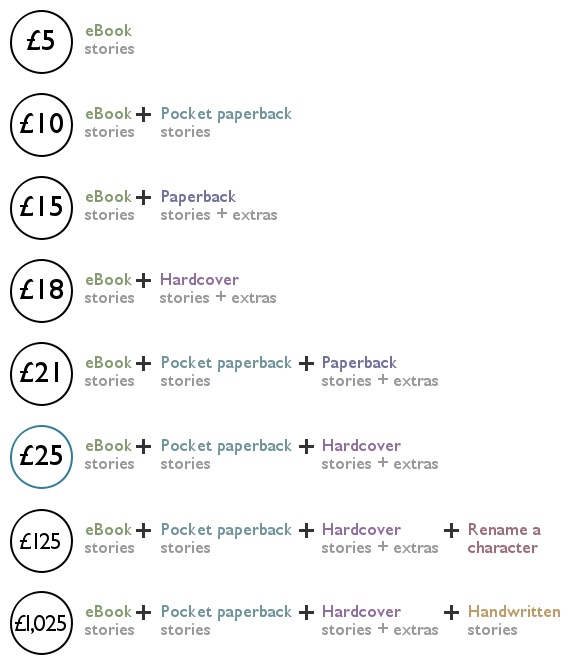
I didn't want my video to be the first thing that people saw and so I had to come up with a striking image to display at the top of my campaign page.
I spent several hours trying out different things with typographic ornaments and script typefaces. I created something that looked like expensive packaging for toiletries.
I then reverted to my original digital image, remembered that off-centred crops create visual interest and went for a blocky typeface to appeal to the guys. I would have liked a pretty script typeface but it looked too girly. My book is for both men and women.

How you can help
It's Sunday today. I'll be launching the campaign on Wednesday. It will run from 30 April to 20 May 2014.
Wish me luck and please back my campaign if only at the minimum level of £1. Thank you.
Visit my Kickstarter campaign.
UPDATE: My campaign was successful!
What next?
I'll be able to apply what I've learned from this campaign to future campaigns. In no particular order:
- typographic t-shirts based on pangrams
- merchandise based on typographic images involving facts from a given year
- the role of Twitter in two major events in the UK in 2011
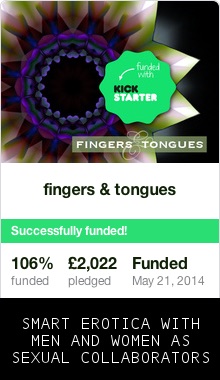
Comments (1)
Anna
says:Congratulations on this very public step towards the launch! That was a really interesting read with some great information for others who might want to give it a go. You clearly did a huge amount of background work to set it all up. I really hope it all pays off.